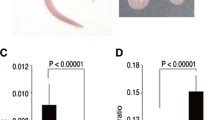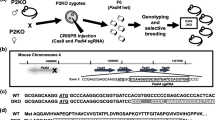Abstract
Pituitary adenylyl cyclase-activating polypeptide (PACAP) and vasoactive intestinal peptide (VIP) are two closely related neuropeptides exhibiting overlapping activities which have actions on almost every organ system of the body. To determine if these peptides exert essential but redundant functions, we interbred VIP- and PACAP-deficient mice to obtain VIP/PACAP double knockout (DKO) mice. DKO mice had normal birth weights and survived to weaning, but exhibited a dramatic postnatal growth rate reduction. Analyses at postnatal day 16 indicated that all organs examined except the brain were reduced in mass by 40–70% compared to mixed background controls, with the thymus and spleen most profoundly affected. Brain size was also significantly reduced, but by only 10%. The reduced growth rate of DKO mice was associated with reduced serum concentrations of insulin-like growth hormone-1 (IGF-1), but unchanged levels of growth hormone. Despite the normal survival of DKO mice up to the weaning stage, many subsequently experienced early sudden death, with only 48% of females and 82% of males surviving past 6 months. The results indicate that a significant percentage of mice deficient in both VIP and PACAP survive to adulthood, but their growth rate is profoundly affected, and that females in particular exhibit high rate of mortality after about 3 months of age.








Similar content being viewed by others
References
Abad, C., Niewiadomski, P., Loh, D. H. -W., & Waschek, J. A. (2006). Neurotransmitter and immunomodulatory actions of VIP and PACAP: lessons from knockout mice. International Journal of Peptide Research and Therapeutics, 12, 297–310. DOI 10.1007/s10989-006-9032-5.
Asnicar, M. A., Koster, A., Heiman, M. L., Tinsley, F., Smith, D. P., Galbreath, E., et al. (2002). Vasoactive intestinal polypeptide/pituitary adenylate cyclase-activating peptide receptor 2 deficiency in mice results in growth retardation and increased basal metabolic rate. Endocrinology, 143, 3994–4006 Medline DOI 10.1210/en.2002-220354.
Colwell, C. S., Michel, S., Itri, J., Rodriguez, W., Tam, J., Lelievre, V., et al. (2003). Disrupted circadian rhythms in VIP- and PHI-deficient mice. American Journal of Physiology. Regulatory, Integrative and Comparative Physiology, 285, R939–949 Medline.
Colwell, C. S., Michel, S., Itri, J., Rodriguez, W., Tam, J., Lelievre, V., et al. (2004). Selective deficits in the circadian light response in mice lacking PACAP. American Journal of Physiology. Regulatory, Integrative and Comparative Physiology, 287, R1194–1201 Medline DOI 10.1152/ajpregu.00268.2004.
Delgado, M., Pozo, D., & Ganea, D. (2004). The significance of vasoactive intestinal peptide in immunomodulation. Pharmacological Reviews, 56, 249–290 Medline DOI 10.1124/pr.56.2.7.
Desai, M., Crowther, N. J., Lucas, A., & Hales, C. N. (1996). Organ-selective growth in the offspring of protein-restricted mothers. British Journal of Nutrition, 76, 591–603 Medline DOI 10.1079/BJN19960065.
Girard, B. A., Lelievre, V., Braas, K. M., Razinia, T., Vizzard, M. A., Ioffe, Y., et al. (2006). Noncompensation in peptide/receptor gene expression and distinct behavioral phenotypes in VIP- and PACAP-deficient mice. Journal of Neurochemistry, 99, 499–513 Medline DOI 10.1111/j.1471-4159.2006.04112.x.
Gray, S. L., Cummings, K. J., Jirik, F. R., & Sherwood, N. M. (2001). Targeted disruption of the pituitary adenylate cyclase-activating polypeptide gene results in early postnatal death associated with dysfunction of lipid and carbohydrate metabolism. Molecular Endocrinology, 15, 1739–1747 Medline DOI 10.1210/me.15.10.1739.
Gray, S. L., Yamaguchi, N., Vencova, P., & Sherwood, N. M. (2002). Temperature-sensitive phenotype in mice lacking pituitary adenylate cyclase-activating polypeptide. Endocrinology, 143, 3946–3954 Medline DOI 10.1210/en.2002-220401.
Gressens, P., Hill, J. M., Gozes, I., Fridkin, M., & Brenneman, D. E. (1993). Growth factor function of vasoactive intestinal peptide in whole cultured mouse embryos. Nature, 362, 155–158 Medline DOI 10.1038/362155a0.
Gressens, P., Hill, J. M., Paindaveine, B., Gozes, I., Fridkin, M., & Brenneman, D. E. (1994). Severe microcephaly induced by blockade of vasoactive intestinal peptide function in the primitive neuroepithelium of the mouse. Journal of Clinical Investigation, 94, 2020–2027 Medline DOI 10.1172/JCI117555.
Hamelink, C., Tjurmina, O., Damadzic, R., Young, W. S., Weihe, E., Lee, H. W., et al. (2002). Pituitary adenylate cyclase-activating polypeptide is a sympathoadrenal neurotransmitter involved in catecholamine regulation and glucohomeostasis. Proceedings of the National Academy of Sciences of the United States of America, 99, 461–466 Medline DOI 10.1073/pnas.012608999.
Hashimoto, H., Shintani, N., Tanaka, K., Mori, W., Hirose, M., Matsuda, T., et al. (2001). Altered psychomotor behaviors in mice lacking pituitary adenylate cyclase-activating polypeptide (PACAP). Proceedings of the National Academy of Sciences of the United States of America, 98, 13355–13360 Medline DOI 10.1073/pnas.231094498.
Institute of Laboratory Animal Resources (U.S.) (1996). Guide for the care and use of laboratory animals. Washington, D.C.: National Academy.
Jamen, F., Persson, K., Bertrand, G., Rodriguez-Henche, N., Puech, R., Bockaert, J., et al. (2000). PAC1 receptor-deficient mice display impaired insulinotropic response to glucose and reduced glucose tolerance. Journal of Clinical Investigation, 105, 1307–1315 Medline DOI 10.1172/JCI9387.
Lelievre, V., Favrais, G., Abad, C., Adle-Biassette, H., Lu, Y., Germano, P. M., et al. (2007). Gastrointestinal dysfunction in mice with a targeted mutation in the gene encoding vasoactive intestinal polypeptide: a model for the study of intestinal ileus and Hirschsprung’s disease. Peptides, 28, 1688–1699 Medline DOI 10.1016/j.peptides.2007.05.006.
Lim, L. M., Stack, C. M., Cuasay, K., Stone, M. N., McFarlane, H. G., Waschek, J. A., et al. (2008). Regardless of genotype, offspring of VIP deficient female mice exhibit developmental delays and deficits in social behavior. International Journal of Developmental Neuroscience.
Lutz, E. M., Ronaldson, E., Shaw, P., Johnson, M. S., Holland, P. J., & Mitchell, R. (2006). Characterization of novel splice variants of the PAC1 receptor in human neuroblastoma cells: consequences for signaling by VIP and PACAP. Molecular and Cellular Neurosciences, 31, 193–209 Medline DOI 10.1016/j.mcn.2005.09.008.
Otto, C., Hein, L., Brede, M., Jahns, R., Engelhardt, S., Grone, H. J., et al. (2004). Pulmonary hypertension and right heart failure in pituitary adenylate cyclase-activating polypeptide type I receptor-deficient mice. Circulation, 110, 3245–3251 Medline DOI 10.1161/01.CIR.0000147235.53360.59.
Underwood, L. E., Thissen, J. P., Lemozy, S., Ketelslegers, J. M., & Clemmons, D. R. (1994). Hormonal and nutritional regulation of IGF-I and its binding proteins. Hormone Research, 42, 145–151 Medline.
Vaudry, D., Gonzalez, B. J., Basille, M., Yon, L., Fournier, A., & Vaudry, H. (2000). Pituitary adenylate cyclase-activating polypeptide and its receptors: from structure to functions. Pharmacological Reviews, 52, 269–324 Medline.
Wu, J. Y., Henins, K. A., Gressens, P., Gozes, I., Fridkin, M., Brenneman, D. E., et al. (1997). Neurobehavioral development of neonatal mice following blockade of VIP during the early embryonic period. Peptides, 18, 1131–1137 Medline DOI 10.1016/S0196-9781(97)00146-0.
Zhou, Y., Xu, B. C., Maheshwari, H. G., He, L., Reed, M., Lozykowski, M., et al. (1997). A mammalian model for Laron syndrome produced by targeted disruption of the mouse growth hormone receptor/binding protein gene (the Laron mouse). Proceedings of the National Academy of Sciences of the United States of America, 94, 13215–13220 Medline DOI 10.1073/pnas.94.24.13215.
Acknowledgements
The present work was supported by the NIH grants CA110384, HD34475, HD04612, and HD06576.
Author information
Authors and Affiliations
Corresponding author
Additional information
Pawel Niewiadomski and Anne-Claire Coûté-Monvoisin investigators contributed equally to this work.
Rights and permissions
About this article
Cite this article
Niewiadomski, P., Coûté-Monvoisin, AC., Abad, C. et al. Mice Deficient in both Pituitary Adenylyl Cyclase-activating Polypeptide and Vasoactive Intestinal Peptide Survive, but Display Growth Retardation and Sex-dependent Early Death. J Mol Neurosci 36, 200–207 (2008). https://doi.org/10.1007/s12031-008-9085-3
Received:
Accepted:
Published:
Issue Date:
DOI: https://doi.org/10.1007/s12031-008-9085-3




